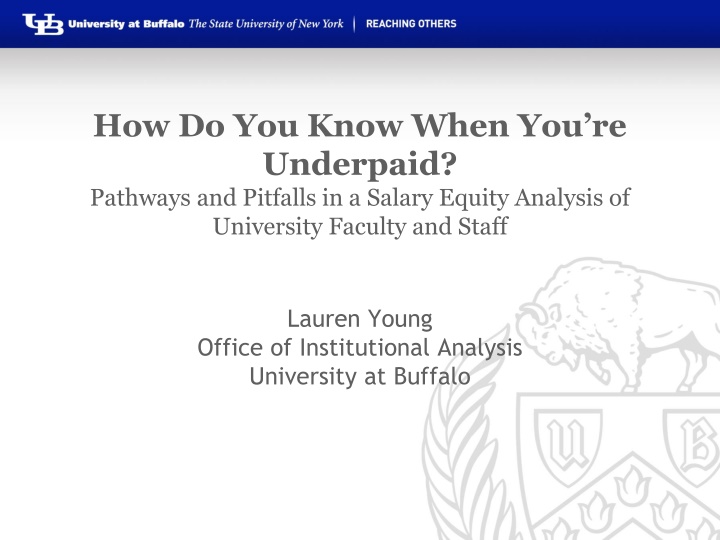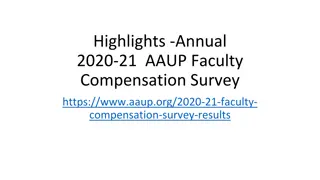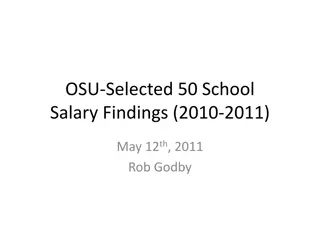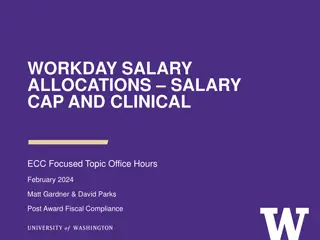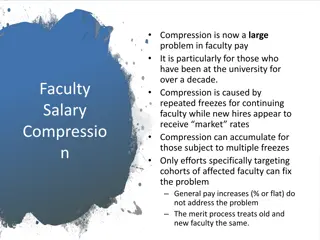Salary Equity Analysis of University Faculty and Staff
Exploring pathways and pitfalls in a salary equity analysis of university faculty and staff, this study delves into identifying predictors of salary inequity and methods for analyzing wage gaps. From alternative predictors like training and experience to OFCCP's minimum set of predictors, various factors affecting salary levels are discussed. The study also highlights the underrepresentation of women and minorities in faculty roles, especially in STEM disciplines, and the cumulative costs of inequity over professional lifetimes.
Download Presentation

Please find below an Image/Link to download the presentation.
The content on the website is provided AS IS for your information and personal use only. It may not be sold, licensed, or shared on other websites without obtaining consent from the author.If you encounter any issues during the download, it is possible that the publisher has removed the file from their server.
You are allowed to download the files provided on this website for personal or commercial use, subject to the condition that they are used lawfully. All files are the property of their respective owners.
The content on the website is provided AS IS for your information and personal use only. It may not be sold, licensed, or shared on other websites without obtaining consent from the author.
E N D
Presentation Transcript
How Do You Know When Youre Underpaid? Pathways and Pitfalls in a Salary Equity Analysis of University Faculty and Staff Lauren Young Office of Institutional Analysis University at Buffalo
Beyond Overworked and Underpaid National Data 60% 50% Percent Female 40% 30% 1972* 2004 20% 10% 0% Doctorates First Faculty Full professors professional degrees *Title IX prohibits gender discrimination in 1972
Beyond Overworked and Underpaid Women made up 39% of full time faculty and 48% of part time faculty in 2004 IPEDS shows underrepresented minorities making up only ~13% of faculty of known ethnicity in 2010 Issues exacerbated in STEM disciplines Costs include threats to faculty and staff morale and inability to foster a culture of diversity Cumulative costs of inequity to faculty and staff (and students?) over lifetimes
Identifying Alternative Predictors of Salary Inequity Training and experience Highest degree earned Time since degree Time in title Productivity and merit Number of publications Grant dollars awarded Rank
More Alternative Predictors of Salary Inequity Quality of work Citations Awards Discipline Market factors Average pay (CUPA) Past/present administrative responsibilities Others?
OFCCP Minimum Set of Salary Predictors 1. 2. 3. 4. 5. 6. 7. 8. 9. 10. Race Time at institution Time in title Age Part time vs. full time Salaried vs. hourly Salary grade or rank Location Similarly situated employment group (SSEG) Gender
Three Equity Analysis Methods 1. 2. Single regression analysis of total population Single regression of majority group with analysis of discrepancies in minority group (residual analysis) Comparison of separate regression analyses of majority and minority groups (Oaxaca decomposition) 3. All analyses have common goal of describing unexplained wage gap
Single Regression with Total Population Simple and efficient Relatively easy to communicate to non-statisticians Method assumes that other predictors of salary have same impact on men and women; if not, inequity can be masked SSEGs typically analyzed using separate models, assuming minimum headcounts
Hierarchical Blocked Regression Explains the Over and Above + UNDERREPRESENTED MINORITY STATUS + GENDER or FTE
Hierarchical Blocked Regression Explains the Over and Above Sample Data Change in Salary (B) Change in Explained Salary (R2) Significance (p) Predictor Block 1 56.3% --- Full Professor --- Statistically significant predictors of salary (p<.05) Associate Professor (vs. Full) -20,500 .000 Assistant Professor (vs. Full) -35,300 .000 FTE 5,800 .254 Gender accounts for salary over and above other predictors Years in Position 200 .065 Discipline Market Factor ($K) 800 .000 Block 2 Unexplained wage gap, men>women Female -6,550 .000 9.5%
Majority Group Regression and Residual Analysis Regression equation predicts salary among majority group (men, whites, etc.) Residuals, or discrepancies between minority s actual salary and what majority regression predicts can indicate patterns of bias Average residual = unexplained wage gap Does not mask different pay rates for groups No simple test to identify statistical significance or differential effects of other single predictors
Majority Group Regression Men Only $120,000 $110,000 $100,000 $90,000 Salary $80,000 $70,000 $60,000 $50,000 $40,000 0 2 4 6 8 10 12 14 Years in Title
Majority Group Regression - Residual Analysis of Women $120,000 $110,000 Men Only Regression Line $100,000 $90,000 Salary $80,000 $70,000 Residual = $16,357 $60,000 $50,000 $40,000 0 2 4 6 8 10 12 14 Years in Title
Two Regression Model Different Effects for Two Groups $120,000 $110,000 $100,000 $90,000 Salary $80,000 Men Women $70,000 $60,000 $50,000 $40,000 0 5 10 15 Years in Title Two regression model permits evaluation of different effects of experience on salary for men and women
Two Regression Model Oaxaca Decomposition Creates statistical expression for differential prediction of salary for men and women Combines differences in prediction between majority and minority for more precise calculation of unexplained wage gap but Tests for significance of differences between models and of unexplained wage gap are more complex and time consuming Procedure not intuitive or easy to explain to non-statisticians
How Significant is Significance? Statistical significance generally indicates probability that differences would be found in random sample but Unexplained wage gap is based on actual population, not random sample Size of unexplained wage gaps ( practical significance ) can be more important than statistical significance at p<.05 Consider size of population being analyzed and comprehensiveness of model Good judgment is the key!
A Salary Equity Analysis of Faculty Proactive approach, based on OFCCP audit method and minimum predictor list Attempted to include all with faculty appointments Single regression, total population Substituted FTE for part time / full time dichotomy Added discipline market factor (i.e., average of ladder faculty salaries at AAU peer institutions) to control for demand where appropriate Separate analyses for SSEGs: tenure track, non tenure track, visiting/adjunct, equal opportunity center, librarians
Problems with Predictors Strong intercorrelations or multicollinearity Age, years at institution, years in title highly correlated and effectively measure the same thing Cannot statistically disentangle the unique effects of each Focus on effect of gender or race/ethnicity might argue for keeping all predictors as background controls Chose to keep only years in title and eliminate others as redundant because other predictors added little and made explanations less clear Length of appointment highly related to discipline 12-month faculty appointments localized within health sciences Higher salaries for 12-month appointments Adjusted 12-month salaries to 9-month level (x .818)
Problems With Predictors Categorical variables, low counts in some categories Only one visiting/adjunct professor with full rank: contrasted assistant vs. combined full/associate ranks Most librarians are associate or senior assistant, few full or assistant librarians: combined full/associate as tenured vs. non- tenured others Some SSEGS just too small Affirmative Action manually reviewed these Missing predictors Productivity: publications, grant dollars Quality: citations, awards
Salary Equity Results for Tenure Track Faculty Change in Salary (B) Change in Explained Salary (R2) Significance (p) Predictor 61.7% --- Full Professor --- Associate Professor (vs. Full) -33,806 .000 Significance for appropriate predictors of salary Assistant Professor (vs. Full) -47,362 .000 FTE 14,523 .103 Years in Position 197 .007 Discipline Market Factor ($K) 613 .000 Not close to significance! Female -1,221 .426 0.0%
Salary Equity Results for Librarians Change in Salary (B) Change in Explained Salary (R2) Significance (p) Predictor 65.6% Tenured Librarian 18,646 .000 FTE 18,767 .060 Years in Position 451 .004 Female 3,058 .233 0.9% Substantial unexplained wage gap Gender effect not approaching statistical significance
A Salary Equity Analysis of Staff Predictors adapted from OFCCP minimum list Attempted to evaluate all with classified or professional staff appointments Included highest degree, which varies considerably more among staff than among faculty (a very large majority of the latter have PhDs) Include time at institution rather than time in title Still highly correlated with age, time in title Slightly stronger relationship with salary, more intuitive predictor in this group SSEGs based on job categories provided by affirmative action office
Job Classification Issues Computer professionals include: Programmer/analysts Database administrators Technicians All professional staff with similar types of responsibilities Senior staff assistants share one title and one pay grade Responsibilities vary widely Professional pay grades cover a large range No disciplinary market factor exists to correct Can only explain 21% of variation in salary for senior staff assistants (vs. 74% for computer professionals) Other job categories include broad titles similar to senior staff assistant
Salary Grade Issues Professional salary grades much broader than classified salary grades Narrower classified salary grades may subsume most of variation in salary Might inequities based on gender or race/ethnicity be harder to detect among classified staff? Salary grades may vary little (or not at all) in some job categories Salary grades often have linear relationship to salary in lower and middle levels but not at the highest levels
Confidence Intervals for Professional and Classified Staff Salaries Within Grades $100,000 $80,000 Salary $60,000 $40,000 $20,000 $0 SL2 (Professional) SL3 (Professional) SG11 (Classified) SG12 (Classified) Salary Grade
Salary Equity Results for Computer Professionals Change in Salary (B) Change in Explained Salary (R2) Significance (p) Predictor 74.0% Salary Grade (Professional) 18,090 .000 FTE 11,098 .210 Years at Institution 723 .000 Less than Bachelors Degree 3,949 .126 Bachelors Degree --- --- Graduate Degree 1,013 .517 Minority 1,342 .599 0.0%
Salary Equity Results for Administrative Support Professionals Change in Salary (B) Change in Explained Salary (R2) Significance (p) Predictor 23.9% FTE 1,550 .210 Years at Institution 444 .000 Less than Bachelors Degree -118 .126 Bachelors Degree --- --- Graduate Degree -1,662 .207 Minority 1,951 .274 0.4%
What Salary Equity Analysis Does Not Do Does not account for bias in hiring and initial packages Does not address bias in promotion and tenure Does not demonstrate why unexplained wage gaps or differential rewards may exist only that they do or do not exist Does not address equity at the individual level
